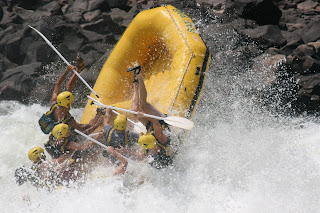As I mentioned before I first thought of Kolwezi as 20 mud huts in the wilderness and then as an urban center with a population of over 400,000 people. In the end it turned out to be somewhere in between but I really feel it was closer to the first than the latter. The neighborhoods we visited had more of the feel of the "mud huts", it's just that there were several thousand of them instead of just 20. They were constructed from clay bricks and the lucky houses had corrugated steel roofs without holes rusted in them. Additional bricks were set on the steel to keep it in place. I can only imagine a muddy dirt floor for the unlucky households. Of course there was a "downtown" sort of area but the buildings seemed to be limited to 2 stories. Roads were severely potholed at best, not paved, rutted and dusty at worst.
Dangers in the Congo
In spite of the recent Ebola outbreak and civil war, I never felt like I was in any sort of danger. Both the Ebola and the fighting were hundreds of miles away from where we were. More pressing was the danger of common diseases such as malaria and typhoid. Even though I was vaccinated or taking pills to prevent malaria, typhoid, yellow fever and hepatitis A & B, those diseases were always on my mind. There weren't many mosquitoes, I think because it was the dry season (hasn't rained since March), but when I did see one I couldn't help but think "malaria with wings." When we were looking at the neighborhood wells and they poured water out, I would think "typhoid in a bucket." Here are a couple rather poignant examples of the presence of disease in everyday life in the Congo and our reaction to it:
1) One of the people we worked with has a good job with WorldVision and has his doctorate. He said that he gets malaria every month or two. He recognizes the feeling of it in the back of his neck and then goes to the doctor. It's not difficult to treat, but this treatment isn't available to everybody. It isn't fiscally practical for the locals to take the preventative medication that I was taking everyday. It is just something that they must live with on an everyday basis.
2) When we went out to visit the neighborhoods, health centers or schools, kids would appear from all over to see us, get their pictures taken and receive the candy or other items that we passed out. They wanted to walk and talk with us, hold our hands and give us five. When we got back into our vehicles to leave, one of the first things we did was to get out the sanitizing liquid and rub it onto our hands. It is not something that any of us felt good about doing but something we had to do nonetheless.
This trip will probably take few posts for me to present the entire picture so keep checking back. Also I'm waiting for some pictures from the other guys to put up. The picture below is of a baobab tree. Truly massive. There are six of us standing in front of this one and we are about half as wide as it is. Amazing.

On the home front I'm told that Cole and Kaori were very well behaved when Robyn and I were gone. Robyn was gone for work from Monday to Friday the same week that I was in Africa. Thanks to Grandma Alice and Grandpa Ron for coming to visit.




